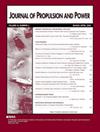石蜡-氧混合火箭发动机燃料形态变化的数值模拟
IF 2.4
4区 工程技术
Q2 ENGINEERING, AEROSPACE
引用次数: 3
摘要
本文采用湍流子模型、化学子模型、流体表面相互作用子模型和辐射子模型进行了reynolds -average Navier-Stokes模拟,以重建以石蜡和气态氧为推进剂的实验测试混合火箭发动机的内弹道。首先,预燃室和后燃室在参考燃烧的初始、平均和最终直径的影响被评估为可以忽略不计。然后,将模拟燃料形状随空间和时间变化的数值模拟与均匀端口半径下的数值模拟进行了比较。后者提供合理的回归速率、压力和最终晶粒剖面预测,并降低了计算成本。另一方面,计算成本较高的燃料形状变化模拟提高了模型预测能力,提供了与实验数据更准确的比较。最后,将燃料形状变化方法成功地应用于节流燃烧的模拟。本文章由计算机程序翻译,如有差异,请以英文原文为准。
Numerical Simulations of Fuel Shape Change in Paraffin–Oxygen Hybrid Rocket Engines
Reynolds-averaged Navier–Stokes simulations with submodels of turbulence, chemistry, fluid–surface interaction, and radiation are performed in this work to rebuild the internal ballistics of an experimentally tested hybrid rocket engine with paraffin and gaseous oxygen as propellants. Firstly, the effects of the prechamber and postchamber cavities at the initial, average, and final diameter of a reference burn are assessed to be negligible. Then, numerical simulations modeling the fuel shape change in space and time are compared to simulations performed at uniform port radius. The latter provide reasonable regression rate, pressure, and final grain profile predictions with reduced computational cost. On the other hand, the more computationally expensive fuel shape change simulations improve the model prediction capabilities providing a more accurate comparison with experimental data. The fuel shape change approach is finally applied with success to simulations of a throttled burn.
求助全文
通过发布文献求助,成功后即可免费获取论文全文。
去求助
来源期刊

Journal of Propulsion and Power
工程技术-工程:宇航
CiteScore
4.20
自引率
21.10%
发文量
97
审稿时长
6.5 months
期刊介绍:
This Journal is devoted to the advancement of the science and technology of aerospace propulsion and power through the dissemination of original archival papers contributing to advancements in airbreathing, electric, and advanced propulsion; solid and liquid rockets; fuels and propellants; power generation and conversion for aerospace vehicles; and the application of aerospace science and technology to terrestrial energy devices and systems. It is intended to provide readers of the Journal, with primary interests in propulsion and power, access to papers spanning the range from research through development to applications. Papers in these disciplines and the sciences of combustion, fluid mechanics, and solid mechanics as directly related to propulsion and power are solicited.
 求助内容:
求助内容: 应助结果提醒方式:
应助结果提醒方式:


